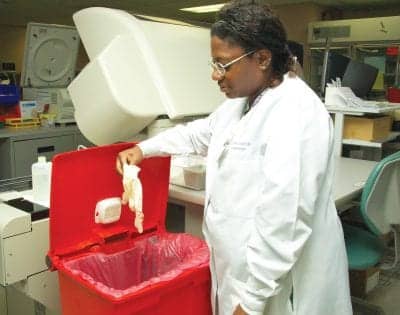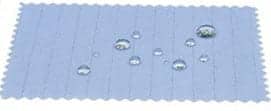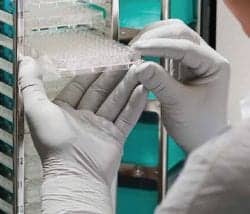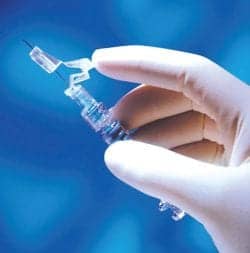
DenLine laboratory coats are designed to assist health care workers who have potential for splash and spray of blood, body fluids, or chemicals, and subject to OSHA Directive(s) CPL 02-02.069.
PHOTO PROVIDED BY SAFETY LADY LLC
As safety concerns are inherent in the clinical laboratory environment, the benefits of adopting a comprehensive safety plan that includes improved health of workers and improved quality of work are central.
All lab workers receive general safety training, usually several times during their career. Sometimes the training can feel like an intrusion on your workday. Sometimes the material is so common sense it may seem almost silly to say it out loud (“Don’t taste or sniff chemicals!”). But despite repetitive safety training and conspicuous Material Safety Data Sheet binders, serious accidents happen.
A 2011 article in Nature covers the accidental deaths of two lab technicians—one at Yale University, and the other at the University of California, Los Angeles (UCLA)—bringing the issue of lab safety to the forefront.1 Michele Dufault, a Yale undergraduate student, died of asphyxiation after her hair tangled in a lathe in the machine shop. Research assistant Sheharbano Sangji died of severe burns she received in a UCLA lab.
In March, UCLA announced its new Center for Laboratory Safety, the first program in the United States to measure the effectiveness of safety policies and develop ways to improve scientists’ approach to safety.
Richard Van Noorden, author of the Nature article, observes, “Around the United States, laboratory directors and safety officers immediately checked their own policies on working practices in machine shops. But the accident [at Yale University] has also heightened wider concerns about the ever-present tension between research freedom and safe working conditions in academia.”
Fortunately, safe working conditions do not necessitate impeding intellectual curiosity. Abiding by safety guidelines is becoming increasingly easier as new lab products and equipment are developed that help reduce the risk of injury. Below is a discussion of some of these innovative products.

Example of fabric impermeability in DenLine’s Protection Plus Splash and Spray resistant fabric, used in the company’s lab coats.
PERSONAL PROTECTIVE EQUIPMENT
Laboratory coats: DenLine Uniforms Inc, Quincy, Ill, carries a washable line of splash- and spray-resistant, breathable, antistatic, and lint-free lab coats for health care and laboratory environments. The coats are particularly useful for people who may potentially be exposed to splash or spray of blood, body fluids, or chemicals; and for people working in rooms that require a clean/no lint, air-permeable, antistatic lab coat. Tapered sleeves and rolled cuffs provide added safety. The fitted sleeves lessen the chance the coat will snag or pick up hazardous materials.
The static-free design (via evenly distributed carbon fibers in the fabric) is of particular interest to personnel working with highly sensitive electronic equipment, as it nearly eliminates static-induced false instrument readings. DenLine’s new lightback design is made of synthetic material with the air permeability of a 65% polyester/35% cotton blend.
Reusable/launderable lab coats, such as those offered by DenLine, are increasingly replacing disposables. Disposable coats generate some 50 times the solid medical waste of reusable coats. Cost savings is contributing to the growth of reusable protective coats. Properly structured, a reusable lab coat program can be less than half the cost of providing protection using disposables.
Gloves: Remember, one lab glove does not fit all situations! You should consider the most hazardous situation or material in the lab and choose the glove that best protects against it. Glove material choices are usually limited to latex or nitrile. Latex exam gloves are cost-effective and provide protection for biological and liquid radioactive hazards, but they do not provide chemical protection and many people are or become sensitive or allergic to latex. Nitrile gloves, typically more expensive than latex, provide the protection of latex as well as hazardous chemical protection. Below is a list of conditions that should play into your choice of glove:
Chemical hazard: Choose a glove that provides the best resistance to the chemical being used. Review degradation, breakthrough, and permeation rates, and remember that double gloving may be needed for some chemical hazards.
Biological hazard: Consider not just the biological material, but also what the material is immersed in (is it water? a solvent?).
Radioactive hazard: Gloves can provide a barrier and help prevent scatter contamination. Glove selection should be based on the solution or solvent material such as water, toluene, and others. Radioiodination procedures require double gloving.
Sharps hazards: Product guides may not indicate susceptibility to punctures, scrapes, or cuts. To get this information, contact the manufacturer or supplier.
Combination hazard: Product guides list gloves by the protection they provide from one chemical, not a mixture of chemicals. In this case, glove selection should be based on the chemical component with the shortest breakthrough rate.
Comfort and usability: Gloves need to be comfortable and not impede you from doing your work (eg, too thick). The line of thin mil nitrile gloves from Kimberly-Clark Professional, Dallas, is a disposable glove designed to provide barrier protection and tactile sensitivity. Its STERLING line of nitrile gloves is thinner and provides the protection of thin mil nitrile with the sensitivity of latex and superior strength. This line also helps to reduce environmental impact and reduce storage needs by delivering more gloves per case than many traditional gloves.
HANDLING OF HAZARDOUS MATERIALS
Fire Prevention: Laminar fume hoods are standard in just about every clinical lab. A recent innovation in hood technology is the automatic fire extinguisher. Captair, from Erlab Inc, Rowley, Mass, offers Fire Foe™ as an add-on accessory to its fume hoods. Fire Foe tubes use heat-sensitive nylon tubing with a patented sealing system to contain and release gas- and powder-extinguishing agents. Fire Foe reacts to both slow-burning and instant flash fires. The tube automatically activates when the temperature in the hood rises above 175°F. The tube discharges at 316°F. The gas portion of the agent interrupts the combustion process by absorbing the heat and chemically extinguishing the fire. The nontoxic, noncorrosive powder element travels with the gas and coats the combustible material to prevent reignition.

Kimberly-Clark’s line of STERLING nitrile gloves combine the protection of nitrile with the sensitivity of latex and superior strength.

BD SafetyGlide™ Shielding Hypodermic Needle. Single-handed immediate activation with minimal change in technique; and permanently attached needle means minimal dead space—minimal drug waste.
Biological sample collection: Sample collection and transfer such as vacutainer caps, bacterial culture work, and centrifugation can also be the site of exposure to hazardous materials. Unsafe injection practices, such as inappropriate vial use and reuse of syringes, exposes patients and health care providers to blood-borne pathogens including hepatitis B and C and HIV. Beckton Dickinson (BD), Franklin Lakes, NJ, has been at the forefront of researching and promoting safe injection technologies. BD has developed safety engineered injection devices that include auto-disposable systems that prevent reuse of syringes and needles. The company also offers prefilled syringes (eg, vaccines), which eliminate the hazards involved with decanting a solution from one container and transferring it to a patient or second container.
The BD Vacutainer® Rapid Serum Tube (RST) is a blood-collection device designed to help acute health care facilities rapidly analyze blood serum. The FDA cleared the device in late 2010. The technology features a safety-engineered closure that enhances safety as well as compatibility with clinical analyzers using front-end automation and point-of-care technology. The RST offers a 5-minute clotting time and 3-minute centrifugation time—translating to a 32-minute savings. The company also offers needle shields on its sample needles, collection sets, infusion sets, and syringes. After use, a hard plastic shield is moved over the exposed needle and locked into position, creating a barrier between the user and the needle.
ENVIRONMENTAL CONSIDERATIONS
Safety can be contextualized in a broader perspective by considering the trend of “greening” labs. In the past few years, chemistry and materials science have begun to emphasize active pro-environmental practice—lab design, research policies, and use of instruments, equipment, and procedures designed to protect the environment from avoidable harm. Tenets of this approach, informally called green chemistry in green labs, include energy-efficient design, increased sensitivity for instruments, smaller-scale sampling, and decreasing solvent use to reduce environmental exposure and chemical waste.
In addition to environmental benefits, rewards include safety, efficiency, reduced costs, and smaller space requirements for the lab. Green chemistry and labs have no specific requirements at present, but guidelines for Leadership in Energy and Environmental Design certification have been developed and are often used as the standard of practice.
ERGONOMIC ISSUES
Many lab tasks involve repetitive movements, such as pipetting, and working at the bench can require hours of standing—both of which can increase risk of injury or strain. Attention to ergonomic design is essential to a healthy and productive employee. Many new items are available to address these issues.
Mettler Toledo, Columbus, Ohio, produces RAININ TechZone Pipettes, an ergonomic line of pipettes. These instruments have a hand-friendly, ambidextrous handle design with a convenient finger-hook (for resting the pipette); LightTouchSystem that reduces tip loading and ejection forces by 85% (eliminates the jamming and rocking movements sometimes required to properly load and eject tips); magnetic assist that reduces the need for a large force differential between the aspiration and blowout springs, allowing for lighter springs and a 25% reduction in plunging forces; and a silicone shock absorber in the ejector tip that greatly reduces impact forces when ejecting tips and gives extra protection for the thumb.
To reduce fatigue and injury caused by standing for extended amounts of time, lab design can incorporate adjustable-height benches and chairs, cutouts to accommodate knee and foot clearance, rails for foot props and rests, gel floor mats, and edge rests and gel pads on bench surfaces.
EMPHASIS ON THE PERSONAL ELEMENT
Good lab safety relies heavily on the personal element: employers instituting safe working practices and ensuring workers are properly trained and have easy access to safety information resources. The Occupational Safety and Health Administration (OSHA) provides many of the guidelines and standards for workplace safety. Employers are tasked by OSHA to provide their workers with a safe environment. OSHA further requires that employers try to eliminate or reduce hazards by making changes in working conditions rather than just relying on masks, gloves, coats, or other types of PPE—as well as actively finding and correcting safety and health problems.
Switching to safer chemicals, trapping harmful fumes by enclosing processes, using smaller amounts of hazardous materials for assays when possible, or using ventilation systems to clean the air are examples of effective ways employers can minimize risks. OSHA regularly publishes updates to its standards and guidelines, and provides a plethora of publications that provide guidance and instruction on safety and health issues in the workplace.
In the past 20 years, the Centers for Disease Control and Prevention’s Biosafety in Microbiological and Biomedical Laboratories has become the code of practice for biosafety—the discipline addressing the safe handling and containment of infectious microorganisms and hazardous biological materials. BMBL provides guidelines that break down laboratory hazards into four levels.2
Another key resource for the latest on lab safety information and investigations is the Chemical Safety and Hazard Investigation Board (CSB). The CSB is an independent federal agency that conducts investigations of chemical accidents and hazards at fixed industrial facilities. The agency does not issue fines or citations, but it does make recommendations to regulatory agencies such as OSHA and the Environmental Protection Agency, industry organizations, and labor groups. CSB is independent of other agencies so that its investigations might, where appropriate, review the effectiveness of regulations and regulatory enforcement.
Sarah Michaud is a contributing writer for CLP.
References
- Van Noorden R. A death in the lab. Nature. 2011;472:270-271.
- Biosafety in Microbiological and Biomedical Laboratories (BMBL). fifth ed. Atlanta, Ga: Centers for Disease Control and Prevention, National Institutes of Health; 2009.


